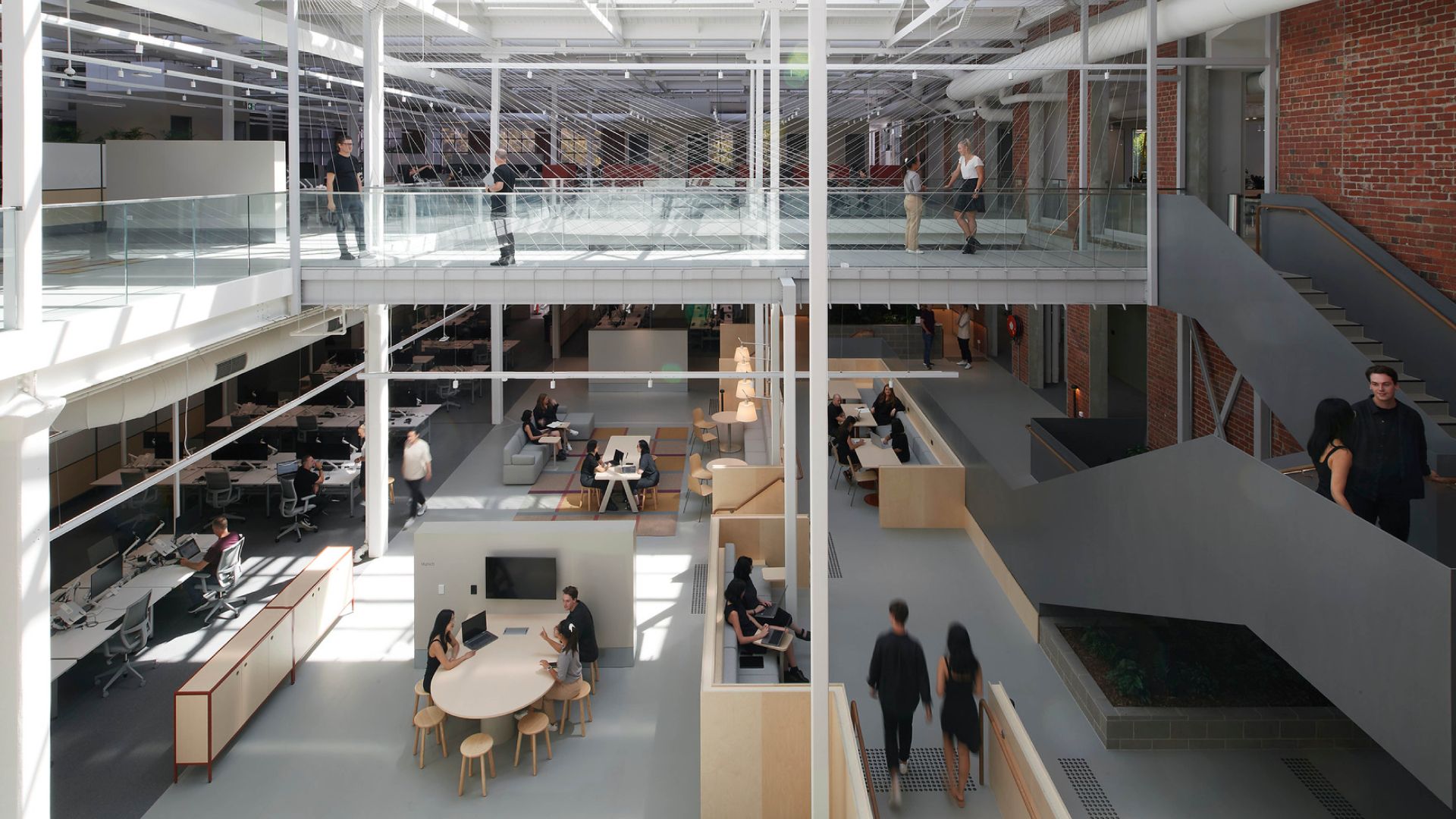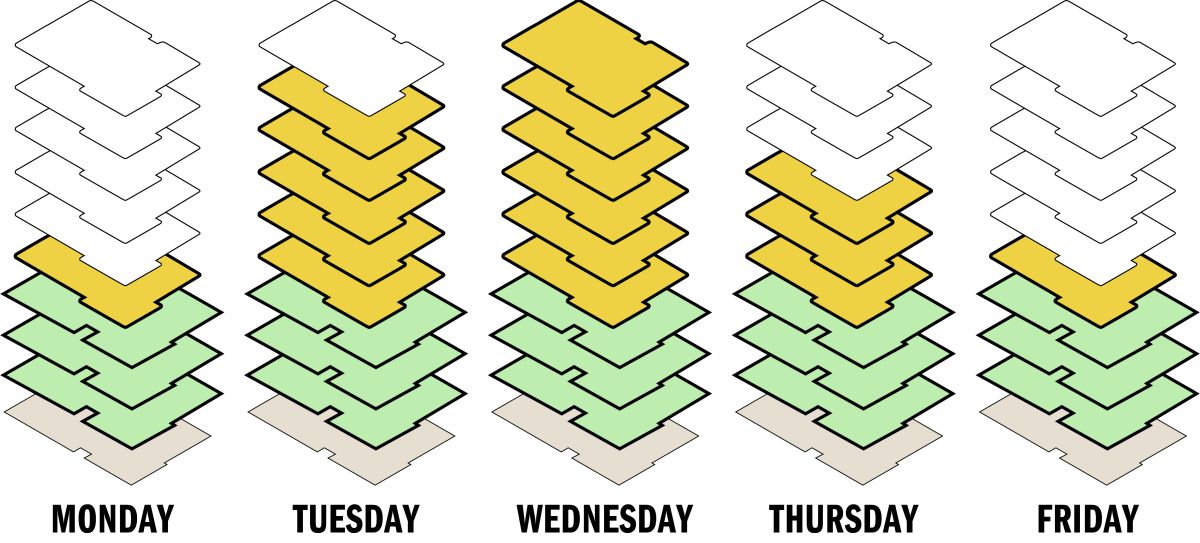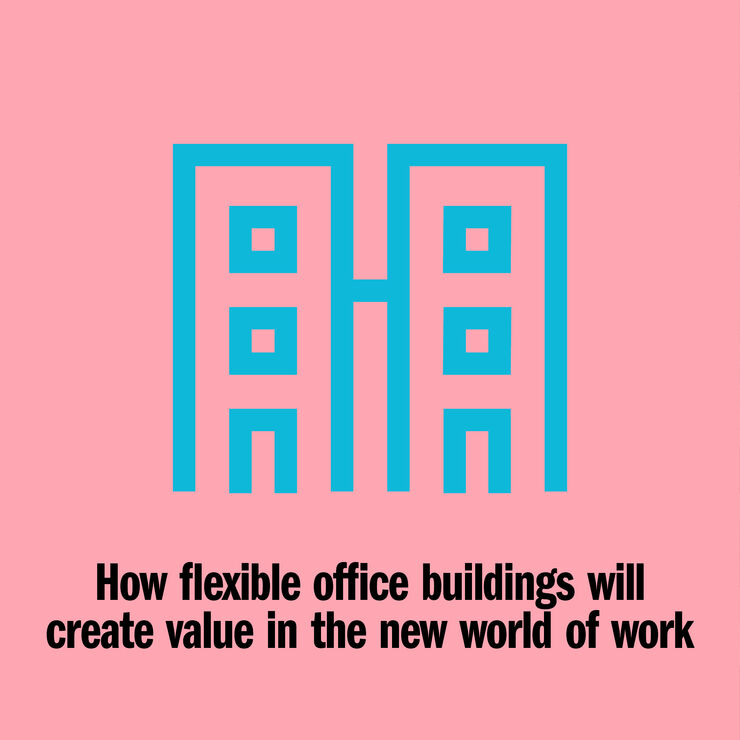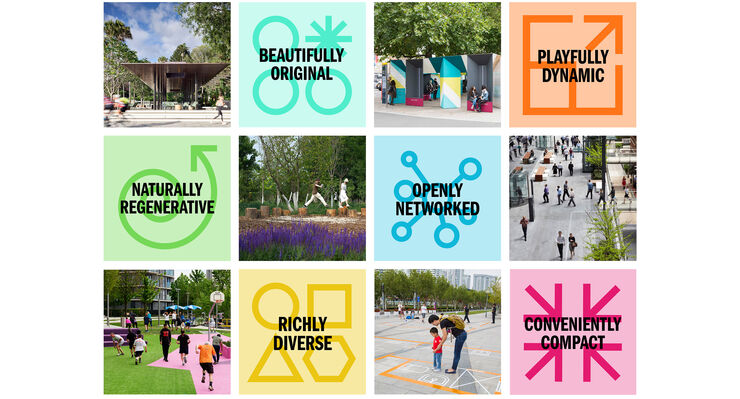The three-day-a-week office: a strategy for the new era of hybrid working

作者
Photography
As companies try to attract employees back to the office, a new challenge has emerged: many workers are only returning three days a week, leaving workplaces deserted on Mondays and Fridays. How do we design for this new era of hybrid working?
With more companies adopting hybrid work, offices are no longer full five days a week. Attendance often peaks in the middle of the week and falls by as much as 50% on Fridays according to studies in Australia and the United States.
These uneven occupancy numbers pose a problem for companies. It’s obviously not efficient (or sustainable) for an office to be half-full on Mondays and Fridays – you’re still paying for rent, air conditioning, lighting, and maintenance regardless of how many show up. On top of that, a sparsely populated workplace feels bare and unwelcoming. Without the buzz and vibrancy of other people, it’s hard to convince employees to come back. Why bother commuting if you’re just going to sit alone on a Monday?
Many organisations are grappling with these weekly fluctuations in occupancy.
Their offices are often ill-equipped to accommodate much variation because they were designed before the pandemic – at a time when occupancy was fairly predictable and consistent.
So if you were going to start over, how do you design an office that is primarily used three days a week? How do you make it feel vibrant and busy on days when attendance is low? How do you prevent it feeling overcrowded in the middle of the week? How do you ensure resources aren’t wasted on empty space, unnecessary air conditioning, and surplus furniture?
ONE CLIENT’S BRIEF: AN OFFICE THAT GROWS AND SHRINKS
About a year ago, an Australian government entity (which we’ll call ‘The Organisation’) asked Hassell to redesign their new headquarters. Like many companies, they were feeling the impact of hybrid work. Their staff had grown accustomed to working from home during the pandemic, and many were reluctant to return to the office five days a week. Those that did return, tended to only come in during the middle of the week, leaving the headquarters lacking life and vibrancy on Mondays and Fridays. The Organisation wanted to start over, to reconsider the purpose of their office, to create something better suited to their new, flexible way of working.
The Organisation had already made some big changes before approaching Hassell. They had consolidated their real estate footprint, downsizing from two buildings to one. But with daily attendance averaging around a third of their 3,400 employees in the middle of the week, the office was still too large. So they made it smaller by mothballing a few floors, turning off air conditioning, lighting, and power.
The Organisation wondered if a similar strategy could be employed in their new headquarters, if the office could be designed so that floors could be dynamically turned on or off.
When it was busy, all of the floors would be open. And on days with lower attendance, surplus floors could be closed. In effect, the office would grow and shrink, always remaining the perfect size for the number of people there that day.
Conceptually, the brief was simple enough. But there were a lot of details for Hassell’s design and strategy teams to work through. In particular, having an office where floors opened or closed on any given day required reconsidering the conventional wisdom about how a workplace is organised.
FLOORS THAT OPEN AND CLOSE
The building for the new headquarters has nine floors. If you are going to periodically open and close some floors, they have to be expendable. That is to say, they can’t contain anything critical to the building’s overall function (you don’t want to be in a situation where you close a floor and find out that people need access to equipment housed there).

In the new building, all the special facilities were placed on the lower three floors – the podium. These floors were designed to house the café, training rooms, kitchen, wellness spaces, IT facilities, client spaces, large conference rooms, and other unique functions. They are always open. So even if other floors are closed, you can still drop by the IT Helpdesk or visit the café. This setup is a bit different from a typical office, which would normally spread amenities throughout the building.
In this case, consolidating the amenities into the podium was an essential step in making the rest of the office flexible.
The remaining six levels are the work floors. They primarily contain workstations, collaborative furniture settings, and meeting rooms. Since all the amenities are on the lower three floors, these six floors are relatively interchangeable. On quiet days, only a few might be open. And on busy days, all six will be open and active.
The meeting rooms were designed to enable this flexible pattern of opening and closing. Analysis of The Organisation’s old office showed that although there was an abundance of large meeting rooms, most meetings were between just two or three people. So in the new office, the meeting rooms were designed to accommodate five people (which saved a lot on construction costs because rooms of this size don’t need supplemental air). Of course, you still need spaces for a few big meetings. The large meeting rooms were placed on the three lower floors with the rest of the amenities and are always accessible no matter which floors are activated.

Given that the work floors open and close based on the daily attendance, the people operating the building need to know, in advance, how many people will be there on a given day. In total, the office has enough desks for half the workforce, and employees are encouraged to come in and use the office as a resource when they need. So it’s not expected that everyone will come in five days a week.
To help make sure the right number of floors are open, employees need to provide a bit of warning that they intended to come in, and make a booking, a bit like a hotel.
CURATION VIA ALGORITHM
Based on employee intentions and plans, an algorithm developed by an external software vendor determines how many floors to open. When an employee arrives at the office, they’re directed to a neighbourhood in the building where their team is located for the day. This is effectively a form of activity-based working – people don’t have a desk that they return to, they instead move to different workstations each day. One day their team might be in a larger neighbourhood, the next they might be in a slightly smaller area, and on quieter days, their team might be consolidated onto a different floor. At the end of each day, they pack up their belongings and take them down to lockers in the podium (unlike other activity-based offices, items can’t be stored near the workstations because the floor might be closed the next day).
Each floor is divided into smaller neighbourhoods – essentially a cluster of workstations, meeting rooms, and lounges. On busy days, when lots of people are in the office, the algorithm will place people in the same neighbourhood as their teammates. On days when fewer immediate teammates are there, the algorithm tries to group people with others from their larger functional or organisational team.
In the future, it’s imagined that the algorithm might use machine learning to more intelligently curate where people sit in order to shape the connections they’re making.
For someone arriving at the workplace, it isn’t immediately obvious how occupied the building is. Access to the floors is controlled by an elevator. On days with lower attendance, people don’t see that the floors are closed. They just get out of the elevator and onto their floor, which still feels busy because people are together. Because it all happens seamlessly and invisibly through elevator access, no one is aware there are uninhabited areas in the building.
When a floor is closed, it saves a lot of energy. The floor’s air conditioning is paused, the lights are turned off, and the power is cut to workstation screens. It also means resources aren’t wasted cleaning unoccupied spaces. For The Organisation, which prioritizes sustainability, this is a big draw. While it feels inefficient to have unoccupied floors, the truth is, if people are mainly coming in three days a week, it’s better to face that reality and structure the office to use resources efficiently on lower attendance days.
THE VERDICT
This strategy of closing and opening floors won’t suit every company. Making it work requires compromises: important amenities can’t be housed on floors that close; employees need to remain mobile and adaptable, which means they can’t have assigned seats; and you need advanced warning of who will be in the office, which means asking people to make a booking to come in. It also requires that an office is of a certain scale – most small or distributed companies don’t have enough office space to be able to close a floor or even part of a floor.
But for The Organisation, these compromises made sense. For them, four advantages made the trade-offs worth it:
- Sustainability: By closing floors, they use less air conditioning and power.
- Efficiency: They save on cleaning, maintenance, and energy costs.
- Activation: On quieter days, the parts of the building that are open still feel lively and stimulating.
- Connections: Because people aren’t sitting alone, they have more chances to bump into others and build bonds in the organisation.
While this workplace sounds unusual, bold changes like this might become the new reality.
Clearly, the pandemic has completely upended how most people and organisations work. At the moment, many of us are still grappling with what this means for the workplace. There’s been a lot of incremental workplace changes – more Zoom rooms, more comforts from home – but there’s also a need for more experimentation from the workplace industry.
That’s not to say that companies should jump into a new, unproven workplace model. Companies need to go back to first principles, consider what their purpose is, what the purpose of their office is, and what works best for their business.
In this project, The Organisation worked with Hassell’s design and strategy teams for nearly nine months. There were workshops, data analysis, and lots of discussion and testing of how the new workplace might operate. The Organisation investigated the right technology to realise their vision. Finally, once The Organisation felt comfortable with the approach, Hassell created physical prototypes of the space and ran a pilot where people tested the new workplace before everyone committed to the strategy. We expect construction to be complete in early 2024 and look forward to sharing more details at that stage.
If you are interested in creating your own three-day-a-week office, contact our strategy team.

扫描二维码关注Hassell微信公众号





